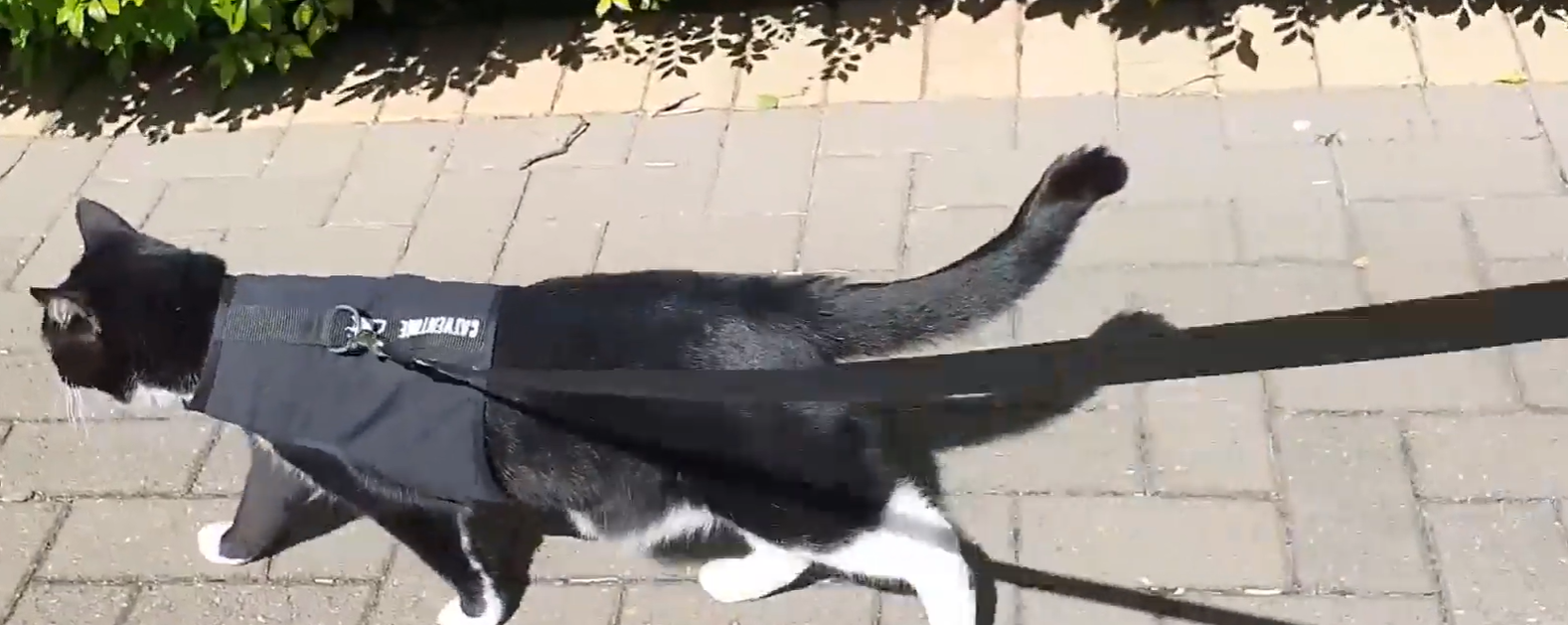在悉尼,遛猫也需要牵绳了

SYDNEY—Alison Clifton's tuxedo cat, Moriarty, loves being outside so much he refuses to eat breakfast before a morning stroll. For Dr. Clifton, that risks a legal cat-astrophe.
Her suburb near the Australian city of Adelaide has made it illegal for pet cats to leave their owner's property alone between 8 p.m. and 7 a.m. To keep Moriarty from a life of crime, but also allow him some fresh air and exercise, Dr. Clifton straps him in a harness, attaches a leash and takes him for a walk, often four times a day.
"A lot of people will think it's quite eccentric to see someone walking a cat," she says. "People are curious and amused."
More towns in Australia are enacting cat-containment rules over frets the ferocious felines pose a threat to the country's unique native wildlife, including small animals such as bilbies and numbats.
About half of municipal councils in some parts of Australia have curbed cats, with fines for owners that can run into the hundreds of dollars. Many have moved beyond nighttime curfews to ban unrestrained cats outdoors at any time. Some areas exempt older felines.
One municipality on the outskirts of Melbourne, called the Yarra Ranges, issued 22 tickets last year. The violation: "Cat at Large or Not Securely Confined."
Owners get creative to comply with the laws. Some buy harnesses and leashes and try to walk a cat for the first time, which can be difficult when starting from scratch. Others build makeshift pens of cat-proof netting, and swap tips on social media about how to assemble them for a modest cost.
Another option is to cough up thousands of dollars to have one professionally installed, sometimes surrounding the whole yard. "Every time a new council passes or proposes a curfew, the phone rings," says Greg Cole of Custom Cat Runs, which builds enclosures.
Feral cats kill billions of mammals, birds and other creatures a year in Australia, and roaming pets add hundreds of millions to that toll, according to Australia's Threatened Species Recovery Hub, a research program backed by the government and universities.
Animal-welfare organization RSPCA Australia, which says keeping cats at home gives them a better chance at a long life, produced a 24-page guide for doing so. Its tips included how to cat-proof a backyard and how to make felines happy indoors, such as by playing music made for cats, providing plants for them to sniff and hiding their food so they have to search for it.
Catfights ensue. Some owners hiss that it's cruel to confine a cat that is used to wandering, and say they have no room to build an enclosure. Others say there are dog parks where canines go off-leash, but there is no cat equivalent. Braden Anderson, whose municipality recently enacted a full-time roaming-cat ban, is trying to keep 11-year-old Willow inside. She recently climbed the screen door, obviously wanting out. He says the ban seems unfair since small creatures are killed by many other animals, such as foxes.
Mr. Anderson, a 40-year-old pub manager, is concerned about the cost of an enclosure and skeptical about walking Willow, who he's worried could tangle with a passing dog.
"She sits at the door, and she is clearly annoyed," he says. "She's been meowing at us to let her outside."
Teaching a cat to use a leash is no walk in the park. Pet owners should start harness training slowly and expect setbacks, says Cat Harness Australia, which makes a brand called Catventure.
Nicholas Brbot, co-founder of the startup company, tells customers to look for the "happy tail": If a cat is walking in a harness with an upright tail, it's comfortable and confident.
Although Dr. Clifton got Moriarty to wear a harness, the cat escaped it once when he was freaked out by rain. Playing it safe, she walks him in her courtyard during curfew hours so she isn't violating the law if he wriggles free again. Other times, they stroll up and down the street.
Dr. Clifton supports the cat rules. She figures they also protect the cats, which, if roaming free, can get into fights, get lost or be hit by a car.
"You can't tell a cat to come home after dark," says Dr. Clifton, a 41-year-old high-school teacher with a doctorate in literature.
For the most part, American towns don't make cat owners lock 'em up, says Alley Cat Allies, a cat-advocacy organization in the U.S. It criticizes curfews as costly and hard to enforce.
"On this and other anti-cat policies, Australia is a true outlier," says Coryn Julien, the group's communications director. "The idea of cats living indoors is a human invention, only made possible by the introduction of Kitty Litter about 70 years ago."
Not long after Kelly Keen brought home Louie, who has a fluffy white-and-gray coat, the cat grew restless indoors. Ms. Keen, whose town bans roaming cats 24 hours a day, bought a harness and supervised him in their yard.
But he was so eager to get out that she and her husband didn't always have time to oblige.
"He was getting like a lion in a cage, just pacing around the perimeter," says Ms. Keen, 34, who works as an office manager.
They got a cat-proof net to secure the yard, but it was tough to set up over such a big area, so she had to prop it up with household items. Eventually she contacted Mr. Cole for a professional installation.
Ms. Keen is for the cat rules, but has mixed feelings. Although they protect birds and small mammals and the felines themselves, she says, they can be stressful for owners, not to mention for the cats.
"That's just what they are—they are cats," she says. "They just want to roam."

